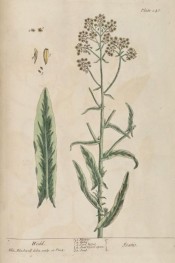Isatis tinctoria L.
Fully hardy, tap-rooted, short-lived perennial or biennial with yellow flowers in early summer. To 1.2m. [RHSE, Hortus].
Horticultural & Botanical History
The leaves produce the blue dye Woad when boiled or fermented with ammonia. The plant also had medicinal uses, applied topically to reduce inflammation. [McLeod]. Paxton’s Dictionary describes Isatis campestris as an introduction from Persia in 1820. This plant may be one of the several varieties listed by Johnson’s Dictionary. Don describes Isatis campestris as ‘very like I. tinctoria’ and gives its origin as Odessa. He records it as growing wild in Britain. ‘Woad. Isatis. The stalks grow about three or four foot high, the leaves are a wilow green, and the flowers yellow. It grows wild in several parts of England, but is generally sown for the use of the Dyers; and flowers in May. Woad is esteemed restringent & drying, and is good to stop inward & outward bleedings. Some commend it much for ruptures & strains, and to strengthen the joints. It is an ingredient in the Emplastrum and Herniam.’ [Blackwell pl.246/1737].
History at Camden Park
Listed only in the 1845 catalogue. Probably imported because of its importance as a source of dye.
Notes
Published Oct 02, 2009 - 11:15 AM | Last updated Oct 02, 2009 - 11:21 AM
| Family | Brassicaceae |
|---|---|
| Category |
|
| Region of origin | Southern Europe |
| Synonyms |
|
| Common Name | Woad, Dyers woad |
| Name in the Camden Park Record | Isatis campestris |
| Confidence level | high |


